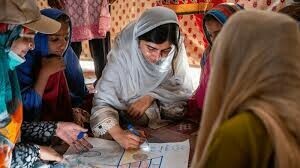WITH 24 million out-of-school children, the provision of quality education is a Herculean task for provincial governments. That said, last month, Finance Minister Ishaq Dar reiterated the PML-N’s pledge of allotting 4pc of GDP to education by 2018. More money will not reform the sector unless there is proper planning. Furthermore, increasing education spending to 4pc is next to impossible to achieve for the PML-N without adding another whopping Rs485bn to up the allocation, according to Alif Ailaan. The current annual allocation of Rs790bn represents 2.83pc of GDP. It would make more sense at this time not to allow development budgets to lapse — most allocations have increased threefold since 2010, such as in KP and Balochistan. In reality, lofty pledges keep the education conversation on the international community’s radar, thus appeasing foreign donors. As an education activist observed: “The government must decide whether education is a commitment it really means, or one it puts in its speeches and manifestos to avoid embarrassment when in international capitals. This is as doable as the Orange Metro Line, or the acquisition of F-16s.”
Therefore, the solution lies in planned utilisation and oversight within the budgetary time frame. Consider Sindh’s dismal indicators despite its high spending on education. For instance, it has the largest overall decrease in learning scores among the provinces — scores attributed to poor quality teaching and low enrolment and retention rates — despite its Rs176bn budget. The province spends at least 12 times as much on teachers’ salaries as it did in 2010. With 50pc of girls out of primary school and 61pc of all girls in this province unable to even attend school, the government must act — even if it means removing bribe-seeking officials patronised by politicians. After decades of donor assistance, 40pc of teachers in Sindh remain ‘ghost’ employees; evident that more money fuels more corruption. Provinces must not overspend on salaries at the expense of needs such as maintaining schools and providing stipends to girls to retain larger numbers. On another note, without an annual national level data collection regime of learning assessments, it is challenging to monitor education outcomes — the last federal assessment was in 2014. This leaves the task to non-governmental advocacy groups, recommending reforms to increase girls’ education, enrolment and retention rates. For equitable education, political interest is necessary — more money without evaluating where it is needed to address gaps won’t solve the crisis.
Published in Dawn, July 10th, 2016








































